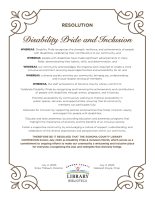Belonging: Disability Advocacy in Libraries
Sonoma County Library
Innovation Synopsis
Disabled community members in libraries often face barriers in spaces meant to be open to all. Sonoma County Library responded by forming the Disability Advocacy Team, a staff-led group representing all levels of the organization. Grounded in lived experience and collaboration, the team is reshaping how libraries understand access—elevating disabled voices, removing barriers, and integrating accessibility into programs, services, and staff culture. Through dialogue, training, and creative problem-solving, the initiative moves beyond compliance to cultivate a culture where every body truly belongs.
Challenge/Opportunity
Libraries often approach accessibility as a checklist rather than a culture. Staff advocated moving beyond compliance toward genuine inclusion but lacked formal ways to elevate disabled voices and address hidden barriers. This challenge became an opportunity to center disability as a vital part of diversity work—empowering staff to lead change from within, reshape perceptions, and create spaces and services that reflect the full spectrum of human experience.
Key Elements of Innovation
The Disability Advocacy Team is a staff-led standing committee that unites employees from all levels to champion disability inclusion. Through monthly meetings, training, and community partnerships, the team integrates accessibility into every facet of service. Collaborations with LightHouse for the Blind, Becoming Independent, Canine Companions, and NAMI strengthen learning and impact. In July 2025, the team led the library’s first countywide Disability Pride Month, featuring a talk with Rachel Zemach, author of “The Butterfly Cage – Joy, Heartache, and Corruption: Teaching While Deaf in a California Public School;” a Common Ground Society Book Club and podcast discussion focused on disability and intersectionality; interactive stations of sensory tools; and a Disability Pride Resolution. This work transforms accessibility and inclusion from a checklist into a culture of belonging.
Achieved Outcomes
The Disability Advocacy Team has sparked a systemwide movement toward true inclusion, translating awareness into bold, tangible change. Staff surveys at launch and one year later measured progress and shaped goals. Staff-led initiatives include a comprehensive branch accessibility audit, a dynamic SharePoint hub for resources and collaboration, and a public-facing accessibility page that amplifies transparency and access. Trainings led by disabled people and advocacy organizations have equipped staff with empathy-driven tools to better serve all patrons, including those with nonverbal communication styles. What began as an internal effort has evolved into a model of culture shift—one now expanding through co-created programs with local partners, participation in the upcoming Disability Expo, and a commitment to embed accessibility into every program and space year-round.


